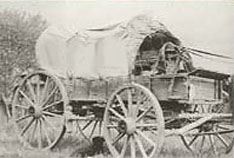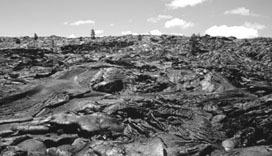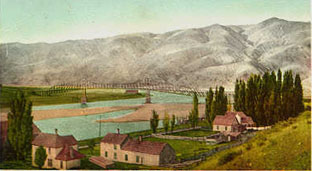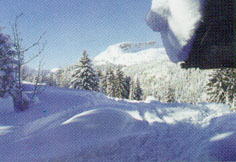
Trip from Elko to Yacolt
By Helen McCutchen Buell
(The saga of the 1892-1894 trip from Elko, Nevada to Yacolt, Washington by JM and Mary McCutchen and their 8 children.)
 |
Maps: Use a larger version of the above map to follow the approximate route of the family's travels. This map comes up on a new screen so you can keep it open and refer to it as you read along. Iv'e also included a map of the route of the Oregon Trail in the Pacific Northwest. I found it interesting to compare these maps and see where the family followed the Oregon Trail and when they didn't.
Several of my family have told about this trip. As with most stories passed down verbally, there were as many versions of this story as there were storytellers. I seldom credit any one source since this is a compilation of all the various versions. Where I've used outside sources to help me choose the most likely scenario, to set times, or to identify locations, I have identified those sources. Sadly, we have no family photos for this period, but I searched the internet to find representative photos (meaning the photo may be of some other area, but conveys the idea presented in the narrative.) I hope these photos adds to your enjoyment of this site. References are cited in Resources along with references for all other McCutchen Northwest pages.
Overview of trip
Mary didn't want her boys to grow up to be cowboys like most of the men she saw in Nevada, (including JM!) so the family sold their property in Nevada and started out, in April of 1892, on a two and a half year oddesy of discovery. JM drove a heavy freight wagon pulled by 4 horses. He was in familiar territory--this is what he'd driven for years before he settled down to be a rancher. In fact, the wagon he drove on this trip could easily have been a wagon from his freighting business (photo) he'd kept when he sold his freighting company, although some say he drove a Conestoga wagon like the one pictured below. Willie was 11, Georgie, 10, Eddie, 9, Walt, 8, Alson, 6, and Cal, 5, rode horses or rode with their dad. Mary took the girls (Avie, 7, and Charlana, 4) with her in a lightweight buckboard. This was a smaller, narrower wagon with high sideboards, pulled by a couple of the more agreeable horses. (Mary, after all, was a city girl and while she could drive a team, it wasn't what she did best!) Canvas-covered hoops protected Mary and her supplies from the weather.
 |
 |
|
Conastoga wagons were considered one of the most functional wagons traveling west. They originated in Pennsylvania where they were first designed and built by German emigrants. They were often pulled by oxen, but JM used horses, as in this photo here. photo source |
Buckboards were smaller than the wagons, and usually rougher riding. Not all were covered but Mary's was. The side boards tended to be even higher than shown here.. (pbs photo no longer on internet) |
The family took along six or seven head of horses, besides the ones pulling the wagons, and a small herd of cattle. Mary kept a milk cow tied behind the buckboard. The boys brought along their favorite farm dogs. When the weather was good, the boys often slept out under the stars, but they brought along a teepee tent and a wall tent so there'd be enough room for everyone to sleep under cover when the weather was less friendly.
The family's original destination was not Yacolt, but Colville, Washington, up near the Canadian border. They'd heard there was land in Colville for "next to nothing'". Colville lies about 1200 miles north of Elko (Yahoo Maps), and the wagons in those days traveled between 10 and 15 miles a day. This means that it was going to take the family 4 months to reach their goal if they traveled every daybut the trip actually took much longer. They stopped here and there, going out of their way to check out likely places to start a new ranch, often taking months while they explored or JM worked at various teamster related jobs that added to their home fund.
The first year the family traveled about 1000 miles to Lewiston. The second year, the family traveled only the 220 or so miles from Lewiston to Colville. After a horrid winter in Colville, they changed their goal and left to find a different place to end their journey. The last year they traveled from Colville to Yacolt, another 650 or so miles. The map shows thier progress each year.
1892
The calvicade of wagons, horses, cattle, dogs and children (not to mention JM and Mary) left their home in Mound Valley, NV probably in early April of 1892. (McCutchen, M.) They took nearly a week to travel the 50 or so miles to Elko, using this leg of the journey as a shakedown trip. After a week or so visiting with the Robersons (JM's sister's family) and many good friends they knew they might never see again the family train headed out for the Idaho border. While in Elko, Mary bought final supplies and JM fixed those problems that had appeared on their shakedown trip.
The next leg of their trip took them about 100 miles to the Idaho border. The family was barely into Southern Idaho when the team JM was driving shied at something and jackknifed the big freight wagon, upsetting it and tossing JM to the ground. When he tried to control the team even as he fell he got his arm pulled out of joint. The family was traveling over grazing land far from any settlements but as luck would have it, there were some men nearby driving a herd of cattle from one grazing range to another. A couple of strapping big cowpunchers held JM down while another couple grabbed his arm pulled it back in place. (Let's hope they got him drunk first so the pain wasn't quite so bad!) In time, the arm healed fine, but JM was crippled for the rest of that year's trip. Will took over the responsibility of driving the big wagon.
In Southern Idaho, probably near Twin Falls (Moeller), the family crossed large flow of lava rock, traveling on the rugged land for miles and miles. The local folks told the family they wouldn't make it, that it would shake their wagons to pieces. But JM had faith in his wagons and he didn't want to loose time going around, so they rattled right over the lava. It did shake them all up but the wagons survived and in fact, they were still in good shape when they got to the other side of the flow.
 |
Most of the lava beds in Idaho are in South-central or Southeastern Idaho. There is one south of Twin Falls that is close to the family's probably route of travel. To learn more about these lava beds click here (Moeller). This photo is of lava beds in Hawaii, but you can see how difficult driving a wagon over it would be. (photo source: Gioboc Photos) |
Not long after they left the lava, the family came to a big flat valley and although they drove in the valley for days, the family saw no one. The boys were surprised because it looked like such good land. They saw sage hens, prairie chickens, good grassland, and found fish in a creek. There were no towns, no settlements, no farms. The only life they saw the whole time they were in the valley was a cattle drive passing through at a distance. In 1904, (only a few years after the family passed through) the Twin Falls South Side project "brought water to thousands of acres of arid land and brought it to life". (AI) It could be that the family passed through this same land in the early spring when it appeared more livable than it really was.
The family stopped for two months in Jordan Valley, Oregon, just across the Idaho border. The people in that area were looking for families with children so that they could justify a school teacher. Having 7 of their 8 children of school age made the McCutchens very attractive to this community! They wanted the McCutchens to stay but Mary found the country too similar to Elko and knew that if they stopped there, they'd still be raising cowboys so they moved on. Click here for some beautiful photos of the area and Eastern Oregon in general.
 |
While the family was in the Jordan Valley area, the boys discovered burrow owls. These little owls live in deserted burrows under the desert. The owls were awake by day, sitting on posts and turning their heads, apparently all the way around, to watch the boys. The boys walked round and round the posts trying to get them to wring their own necks. Since the owls were creating the illusion of twisting by flipping their heads back faster than one could see, naturally the boys never succeeded but it wasn't until years later that they found out why. (RRN) |
The family followed the Oregon Train most of the way from Idaho to the Columbia River. Of course, the "Oregon Trail" cuts a very wide swath and has many alternative routes. (See map of Oregon Trail in the Northwest.) Will remembered driving the big cumbersome freight wagon across the Blue Mountains twice. More likely, he drove it across two legs of this mountain range. (See map--and compare it with the Oregon Trail map) We also know they were in Baker, for "an hour or a day". This is where the excited boys saw a cowboy come bursting out of a livery stable on a bucking horse. The horse bashed into a couple of buggies, mashed one of them down, and tore up a lot of wooden sidewalk. The cowboy got his horse straightened out and, no fool, headed quickly out of town to avoid the trouble he was sure to find if he stayed. He just said, "I'll be seeing you." and left.
The Oregon Trail led them next to the White House, a way station or stopover near Echo, Oregon, and not far from the Columbia River. This place impressed the boys so much that when they were adults, they homesteaded nearby. The family had to cross the Columbia River somewhere around here, probably near where Umitilla OR is now. There were no bridges, so their wagons had to be ferried across while the older boys and JM swam the horses and cattle across.
The family's next long stop was in Lewiston. We don't know why, but the family stopped in Lewiston for nearly a year. (McCutchen, M.) While there, JM did freighting for several people including a Mr. English, who took a liking to JM and wanted the family to stay in the Lewiston area. But JM still wanted to check out the Colville land so they moved on again. Click here to see pages from Mary's journal pertaining to Lewiston.
 |
An old postcard of the Snake River bridge between Lewiston Idaho and what became Clarkston, Washington. This is probably about what it looked like when the McCutchens were here. The Lewiston valley was usually 10 degrees warmer than the surounding area and was called the "Banana Belt". In the 1950's I lived on a wheat ranch on a mesa on top of hills like those in the distance but on the Washington side. (Postcard sold by Moody's Collectables ) |
1893
Colville, in Northeast Washington, near the Canadian border, was supposed to have land for "next to nothing". The family found no such land and the winter family spent there was one of the worst in Colville's history, certainly the worst this family from arid Nevada had experienced. The boys saw more snow than they'd ever seen before--and more than they ever wanted to see again. At one time there was 4 foot on the ground. Charlana started school that year and the walk to school was long. It was the older children's job to make sure she and Cal didn't play in the snow along the way and get wet and cold. They often weren't successful and Cal did get his feet frostbitten.
 |
Winter snow in the mountains. Notice the buildup on the roof. I can remember the area around Colville looking very much like this. Although the snow seldom got this deep, it did the winter of 1893 and it was too much for the family from Nevada. (source) |
Being from Vermont, the snow wasn't such a shock to Mary, but the initial unfriendliness of the neighbors was. She was literally shunned by the women of the community until a kindly soul explained to her that the lovely "turkey red" cloth she'd found at the local store and used to make curtains for her cabin was the same red cloth used by the local bawdy house. Mary took down the curtains and the women stopped thinking she was trying to "set up shop" and became friendlier. JM had his own troubles. He contracted with a man called Injun Jim to care for his livestock and by spring, most of the stock had "been lost in the bad weather" but JM was convinced Injun Jim had stolen the stock and sold it. Whatever the reason, most of JM's stock was gone. With all of their trials and tribulations that winter, they were glad to see spring come and you couldn't have paid the family to stay in the area! Years later, when I was a young bride, I lived in Colville and I invited my elderly father to come visit me. He said, "No thanks, I've seen enough of that country!"
1894
The family moved back to Lewiston as soon as the weather allowed safe travel. Although they considered accepting Mr. English's offer and settling there, they did not. Perhaps the Lewiston area made Mary think too much of cowboys. Perhaps letters from her cousin, Charlie Landon, drew them to Yacolt. But whatever the reason, the family was again on the move after a few months in Lewiston.
Retracing their steps to the Washington side of the area where the family crossed the Columbia in 1892, they picked up the Oregon Trail and followed it down the Washington side of the river to The Dalles. Once again unusual weather changed their plans. In those days, ferries carried goods up the Columbia from Fort Vancouver to The Dalles, but in 1894, the river was lower than usual and the ferries couldn't get past the Cascade Falls. Click here for a history of this area and the Indian legend of The Bridge of the Gods which is near Cascade Falls (now Cascade Locks due to manmade changes in the river). Someone was needed to freight cargos by land to The Dalles (sometimes called The Danes then (FHWA). There was an old narrow gage railroad but no engine, so the frieghters would have to use horses and wagons. This was a job made to order for JM. He used his horses, found some wagons, hired eight or nine men and, with his boys, took on the job. Click here for some good (but modern) views of the Columbia River Gorge.
The freighting road was on the Oregon side of the river so the men kept the teams on the Oregon side, but crossed on a ferry each day to the Washington side where the McCutchens had set up camp. Mary and the girls cooked over a campfire for the whole crew and any of the people coming up the river with the cargo.
 |
The children discovered the sweet wild strawberries of the Pacific Northwest and brought back buckets of them for their mother to serve with her sourdough biscuits and some cream from her cow. Her strawberries and biscuits were so popular that when she served them, she didn't have to put much else on the table. (CanoeCountry.com) |
The younger children picked strawberries and sold bowls of them to the people passing through. They started out selling them for a nickel a dish. Then a traveler stopped to give them an economics lesson. Saying, "Hey, you fellows are too cheap!", he wrote "Twenty-five Cents a Dish" on a card and propped it up on their makeshift counter. The children sold even more at the higher price!
Cal, as the youngest of the boys, took a lot of ribbing from family and crew, but once while they were camping at Cascade Falls, he had enough and his remark became a family response whenever we feel bullied. A big burly member of the crew had been teasing Cal while they ate. Little Cal took it for a while but finally he picked up his spoon and waved it at the big man, "If you don't leave me alone," he said, "I'll knock you head over head over with this here spoon."
It was also while the family was still in this area that they had their first experience with Indians. However, since the ones they met were friendly Indians of the Northwest instead of the scary ones they imagined, the children didn't remember much about them. One wonders if some of the more adventuresome boys might not have been a bit disappointed though.
Finally, in the fall of 1894, the family arrived at Yacolt, to be met by Mary's brother, Willie and her cousin, Charlie.
To read about the McCutchens in Yacolt, click here.